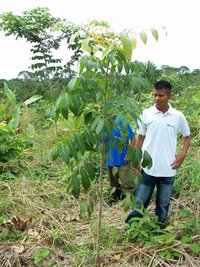Nurturing Social Ventures
/ Employee Liriano Opua inspects a mahogany treeTriplePundit recently did a blog post entitled "Social Entrepreneurs Lag Behind Impact Investors".
Employee Liriano Opua inspects a mahogany treeTriplePundit recently did a blog post entitled "Social Entrepreneurs Lag Behind Impact Investors".
Citing investor feedback from the SOCAP Europe and San Francisco conferences, the author posits that there aren't enough investment-ready social enterprises to meet the growing demand among impact investors.
At the same time, many of the investors at SOCAP Europe, and the SOCAP conference last September in San Francisco, could be heard noting that the supply of investment-ready social businesses is not adequate. It appears that there may be a mismatch between supply and demand, particularly in developing countries where entrepreneurs with great ideas and great companies lack the commercial sophistication, strategic thinking, and organizational systems to handle investments.
The article goes on to suggest that social enterprises need a support network similar to that found in the tech sector. In addition to venture financing, this network should provide idea incubation, mentorship and strong peer support.
From our perspective, the industry-wide need for venture capital is most pressing. We have successfully raised over $140,000 through our investment products, but this hasn't produced sufficient working capital to scale the business. If we can't grow organically through revenues, social venture financing may provide a way for us to scale while maintaining the social and environmental core of the business.
Traditional venture capitalists seek companies that will be profitable in a few years and demonstrate strong exit potential. Social ventures face the additional challenge of maintaining their social mission, which can potentially increase their incubation period or generate a lower return than traditional startups. This creates a financing “dead zone” for social enterprises, which can neither access non-profit funding nor compete for venture capital solely on their return potential.
The success of our business depends somewhat on the overall growth of the impact investing market, which is still young. We’ve seen that the immaturity of the sector dissuades investors from channeling money into impact investments instead of their current donations or traditional investments. Despite improvements in increasing liquidity and measuring impacts, investors are still focused on minimizing their risks with impact investments.
One of the biggest developments in the impact investing space is a common yardstick to compare businesses and investments. The GIIRS initiative intends to establish a common set of social and environmental criteria to measure businesses and their investments. Developing in tandem with the impact ratings system are impact investment exchanges like Impact Investment Exchange Asia and Mission Markets, of which Planting Empowerment is a founding member.
We're doing our part to expand the impact investment universe by providing investments that offer attractive returns and significant social and environmental benefits.



